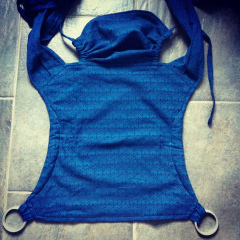Also referred to as: Onbu (no longer considered accurate; "onbu" accurate refers to "wearing on one's back" but is not the correct term for the actual carrier.)
 |
|
Traditional Onbuhimo with rings
Image sourced from cherryberrybaby.co.uk |
Description
A rectangular body panel with two long shoulder straps coming out of the top corners diagonally and two short fabric loops or attached sling rings coming out of the bottom corners horizontally. Baby is put on to the wearer's back high with arms out. The shoulder straps come down, are threaded through the loops/rings and then tied off (typically tied tibetan by crossing the straps back under the opposite shoulder strap and then tying the tails in a double knot.)
Good For
- Front Carries: Not designed for front carries. Possible with long enough straps to cross in the back, add support with reinforcing passes and close off the open sides.
- Hip Carries: Not designed for hip carries.
- Back Carries: Babies who can sit independently only.
- Forward Facing: Not designed for forward facing.
Advantages
Quick to put on and an unpoppable seat makes it easier to wear wiggly or difficult toddlers who may not have the patience for wrapping. Lack of waist belt is great for anybody who doesn't want the pressure on their waist, including (but not limited to) expectant mothers.
Disadvantages
More limited than other carriers, since onbus are really best for older, independently sitting babies and only designed for back carries. Panel size is dependent on child's size. Therefore a parent who chooses to wear as their baby reaches toddlerhood or preschooler age may need to upgrade to a toddler-size or preschool-size carrier.
Variations
- Fabric loops: shoulder straps are threaded through simple fabric loops at the bottom corners
- Ring loops: a small sling ring is attached with a small fabric loop at each of the bottom corners.
- X-Onbuhimo or Blanketless Onbuhimo: Functions the same as a traditional onbu, but instead of separate straps and body panel, it is constructed in an "X" shape with two narrow slings.
- Reverse Onbuhimo: has double rings on the top and wrap straps on the bottom
- Buckle Onbuhimo: a body panel with backpack-like buckle straps and no waistband.
Sizing
Body panel size is based on child's size. Baby needs to be able to fit in the carrier arms-out, but the panel must not be so low that baby can lean backwards. The width should be wide enough to support baby's legs from knee-pit to knee-pit, while still allowing the legs to swing freely at the knee. The strap length is determined by the wearer's size.
How to Use






